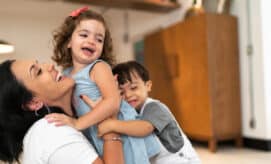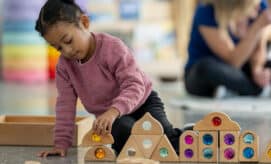Before the onset of the pandemic, when we thought about preparing children for kindergarten, our focus turned to academic skills, such as helping children learn to count and write their names. As educators, we made sure that by the time children were preschoolers, we were engaging them in activities that helped them develop the classroom-related skills they were expected to know when they transitioned into elementary school.
As we emerge from the pandemic, however, it is becoming clear that children’s learning needs have shifted. After months of being at home with just their family members, many children are finding the adjustment to larger group settings to be a bit overwhelming. They are not used to social engagement with other children and are likely to need foundational social-emotional support before they can move to more academically oriented learning.
In this article, we share suggestions for educators and care providers seeking to understand and support the unique, post-pandemic developmental needs of our littlest learners.
The Importance of Emotional Wellbeing
As educators, we know that children learn best when they feel safe, secure, and cared for. Children who feel anxious, stressed, or worried will not be able to try new things or take the risks that are required for learning. The pandemic has exposed children to experiences that can create high levels of stress, including sudden changes in routines, loss of social interactions with friends and neighbors, and even illness or loss of a family member to COVID. All of these experiences impact children’s developing brains and ability to learn.
Jackie Mader, a former special education teacher and ECE journalist, explains how stressful experiences during early childhood impact the developing brain: “When children are exposed to repeated, ongoing stressors during the first few years of life, a pivotal time of brain development, those experiences can have a lasting impact…Without supportive caregivers who can address their needs and help them regulate their emotions, their cortisol levels will remain elevated. This can result in difficulties with executive functioning and decision-making, academic challenges, and behavioral issues.”
This is why it is especially important to put the mental and emotional wellbeing of children at the top of your classroom’s priority list. While many educators feel pressure to ensure that children reach developmental milestones or demonstrate kindergarten readiness , it is important to remember that a sense of emotional safety is foundational to all learning and development. By first supporting a child’s mental and emotional wellbeing, we make it possible for children to thrive— socially, physically, and academically.
How to Support Children
The most fundamental step we can take for children is to meet them where they are. This means acknowledging and accepting that this starting point is different for every child, depending on the child’s age, stage of development, and experiences during the years of COVID disruption. The following resources and ideas can help you to connect with the children in your care, support their emotions, and help them learn to navigate their feelings.
Routines for Comfort & Security
Maintaining clear, predictable routines for the children in your care will help them gain a sense of security. Knowing what to expect throughout the day can be especially comforting following the uncertainty and lack of predictability we all experienced following the onset of COVID.
Rachel Supalla, an ECE educator, director, and coach, helped the children at her center feel safe and welcome by inviting them to bring in a comfort item, such as a favorite stuffed animal, to ease the transition from home to school. Designating safe places within each classroom provides an option for children to visit if they are feeling overwhelmed or in need of a break.
Incorporating Mindfulness
An article from the Child Mind Institute explains that “incorporating mindful practices into your daily routine can help calm anxiety and build healthy coping skills.” This can be as simple as taking time to pay attention to where you are, what you are experiencing, and how you are feeling. Activities such as blowing bubbles and paying attention to their different shapes, drawing a picture of the bubbles, and describing the bubbles’ colors and textures, are examples of simple ways to encourage mindfulness. Noticing and describing bubbles or other items can help young children become more aware of their feelings and practice communicating their emotions.
For more examples of mindfulness activities, you might enjoy the article, A Collection of Mindfulness Activities for Children Aged 3-5 Years, which is available in English, Spanish, French, Portuguese, and Arabic.
A Trauma-Informed Approach
Incorporating trauma-informed practices into our early childhood programs can help us support children emerging from the often-traumatizing impacts of the pandemic.
Adam D. Brown, PsyD, clinical assistant professor in the Department of Child and Adolescent Psychiatry at NYU and member of the Child Study Center, explains that “traumatic events are typically situations that are out of our control, beyond our usual experience, and cause us to feel as though our lives or the lives of others may be in danger…the COVID-19 pandemic certainly is an unusual, unexpected event that is causing many to worry.”
Dr. Brown offers the following suggestions for using a trauma-informed lens to support children’s emotional well-being:
-
Create opportunities to check in. Ask children how they are doing and how they are feeling. These do not have to be long conversations, just quick check-ins during activities such as circle time or morning drop-off.
-
Label and talk about feelings. When children are upset or angry, use language to describe and validate their emotional experience. You might say things like, “You are really frustrated by all of these changes. It has been very overwhelming,” and then provide the child with a hug or some sort of comfort to support them and help them process their feelings.
-
Pay attention to your own reactions. Children are very sensitive and aware of the reactions of their parents and caregivers. When grown-ups are upset, children will likely become upset as well. You can help children cope by ensuring that you are taking care of yourself and managing your own feelings. You might even talk to children about the things you do to calm yourself, such as taking deep breaths, shutting your eyes, or listening to music. Sharing your own experience is a wonderful way to model simple activities that soothe big feelings.





